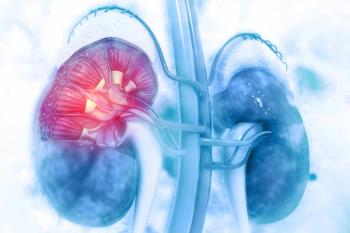
Sunitinib Breaks Feasible for Treatment-Naive Metastatic RCC
Breaks from active sunitinib treatment for patients with treatment-naive metastatic renal cell carcinoma may be possible without effecting clinical efficacy.
Breaks from active sunitinib treatment for patients with treatment-naive metastatic renal cell carcinoma (RCC) may be possible without effecting clinical efficacy, according to the results of a study
“The results of this trial suggested that implementation of this approach in select patients may result in reduced toxicities, improved quality of life, cost savings, and potentially improved clinical outcomes,” wrote Moshe C. Ornstein, MD, of Cleveland Clinic Taussig Cancer Institute, and colleagues.
According to the study, most patients treated with VEGF inhibitors eventually develop resistance.
“In an attempt to minimize the cumulative toxicities while maximizing treatment efficacy, treatment breaks, dose reductions, and alternative dosing schedules have been prospectively incorporated into the development of sunitinib and other metastatic RCC therapies,” the researchers wrote.
In this study, Ornstein and colleagues enrolled 37 patients with previously untreated disease. Patients received 4 cycles of sunitinib 50 mg once per day for 4 weeks. Patients with a 10% or greater reduction in tumor burden took a break from treatment with restaging scans performed every 2 cycles. Patients with a 10% or greater increase in tumor burden had sunitinib reinitiated for 2 cycles and withheld again if there was a 10% or greater reduction in tumor burden. This pattern continued until disease progression or unacceptable toxicity.
Of the 37 patients in the study, 20 patients were eligible for the intermittent phase and all 20 entered this phase. Among those patients not eligible for intermittent therapy, 13 had progressive disease, one had unacceptable toxicity, and three withdrew consent.
After the first 4 cycles of therapy, the objective response rate was 46%. The median increase in tumor burden during the sunitinib break was 1.6 cm and the decrease during retreatment periods was 1.4 cm.
“The range of treatment-break duration is long, including three patients who have not restarted therapy since entering the intermittent phase; this reflects the heterogeneous biology of metastatic RCC,” the researchers wrote.
According to the study, most patients had a “stable sawtooth pattern” first of reduction in tumor burden while on sunitinib and then increase while on the treatment break. The median progression-free survival was 22.4 months and median overall survival was 34.8 months.
“A practical concern of extended breaks from VEGF-directed therapy is the hypothesis that during periods of treatment discontinuation, there is a drastic rise in VEGF levels that can result in rapid tumor growth,” the researchers wrote. “Patients in this trial who experienced progressive tumor growth with each discontinuation period (ie, not returning to the baseline/lowest tumor burden after retreatment) did not experience any adverse clinical outcomes and were transitioned back to the traditional dosing 4/2 schedule without extended breaks.”
Newsletter
Stay up to date on recent advances in the multidisciplinary approach to cancer.
















































































